Spousal contributions
Spousal contributions are one of three ways to add to your spouse’s super. Read on to find out if you are eligible to make spousal contributions, how much of a tax offset you can get, and whether it is better to make spousal contributions, or concessional contributions to your own super. Read on »











